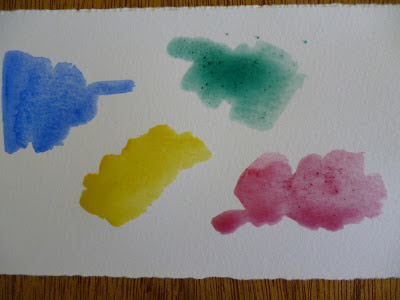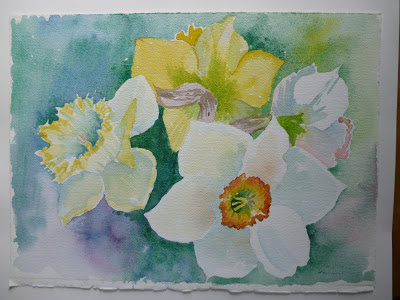I've painted with watercolors most of my life and though they are considered a difficult medium, you need to think in terms of not minding "mistakes" since, unlike oils whereby you can paint over a problem, in watercolor, it's right there looking at you. But, I find that simply thinking of watercolor as "play" helps move things along. For instance, you can wet down your paper, drop in different colors here and there, then, as the paper dries, go back in and define your subject. Or, of course, you can be more precise which I admit to being with the art-work presented here.
But, I want to talk here about using a limited palette. Only four colors. I've squeezed mine into a simple little Winsor-Newton dish (see above) which I can carry around with a single brush and a little bottle of water if I want to go out and paint en plein air.
(All the paintings illustrated here are done with only these four pigments ... except for one, so noted.)
 |
| "Cow Creek at Pecos" |
These particular four colors are among watercolors' most transparent. Some months back I wrote a posting about painting on plasticized paper whereby the paints could easily be lifted off with a wet brush. But these particular four colors lend themselves to lifting off as well--though not as completely. They also mix beautifully together, not producing mud. And they seem to shine on white paper with a wonderful luminosity.
 |
| "Summer Mowings" |
 |
| "Lisianthus Dawning" |
These Fabulous Four--Cobalt Blue, Viridian, Aureolin, and Rose Madder Genuine--are what are called transparent colors because they allow more of the white paper to show through. (Conversely, the Cadmiums, Prussian Blue, and French Ultramarine are among the opaque colors.)
 |
| Left to right: Cobalt Blue, Aureolin, Viridian, Rose Madder Genuine |
 |
| "Daffodil Morning" |
 |
| "Cosmos at Fiesta Time" (Though most of this is done with only the four pigments, I dropped some Winsor Red and Cadmium Yellow Deep into the center to draw in the eye.) |
 |
| "St. Gauden's Apple Tree" |

No comments:
Post a Comment